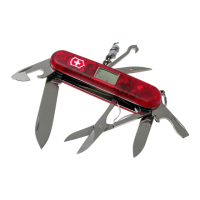November 5, 2015 4/10
Under normal weather variations, an altitude
difference of 40 - 50 m may easily occur after
a single day. If the pressure difference is
great (storm front), a change of up to 100 m
is also realistic. Over a two-day period, a dif-
ference of 200 - 250 m may occur in the
event of extreme weather changes.
1 mbar > approx. 8 m
(or approx. 16 m at 5'500 m above sea level)
1 hPa = 1 mbar = 0.001 bar = 0.75 mmHg
Because of these air pressure fluctuations,
an altimeter must always be readjusted be-
fore use. Set the altitude on a daily basis if
you are hiking or climbing or wish to take ac-
count of weather changes. This means that
the altimeter must be reset at a known alti-
tude (e.g. at home, at a railway station,
mountain hut etc.).
Altitude setting with weather correction
The altitude calculation is made using the in-
ter-national altitude formula. This is based on
an average air temperature value and pres-
sure distribution. The different air pressure
must be set before leaving on a hike by en-
tering the known present altitude. However,
the formula does not make allowance for the
different temperature layers which influence
the effective air pressure. It is also difficult to
measure the precise air temperature in a
layer of air. The subjective impression as to
whether it is warmer or colder than the US
standard is much simpler.
Altitude formula
Standard: based on CINA- and US-
Standard
These are the standard values on which the
altitude formula is based:
> Sea level 15°C
> per 1000 m altitude increase 6.5°C tem-
perature reduction
Example:
Sea level = 15°C
1000 m above sea level 15°C-6.5°C = 8.5°C

